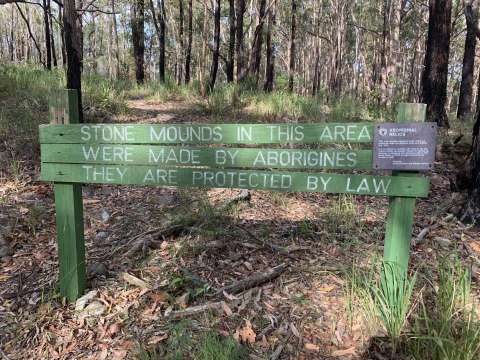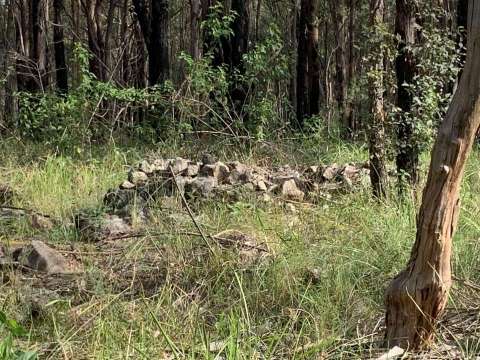Up on a hill behind Promontory Way there is a sign stating that there are Aboriginal Artefacts on the site. Last week I published an article by Patricia Neal, whose family built a house at the Cove in the 1950’s. Patricia spoke about the site and said that the piles of rocks on the site were actually put there by army personal when they used the area for training in the late 60’s and 70’s. She said that her family had even dug up an army greatcoat from amongst the rocks. It would be interesting to know the views of the local aboriginal communities about the site. I have spoken to Len Roberts and he thinks that it is an army site.
There are quite a few aboriginal artefacts in the North Arm Cove area. Aboriginals would have lived in the area for thousands of years and the most common relics are shell middens. The white settlers also used shell for a variety of purposes, so without digging, it can be difficult to identify genuine aboriginal sites. However, I suspect the shell fragments on the northern end of The Ridgeway and another site at Beauty Point are both Aboriginal middens.
An archaeological survey was carried out in the Carrington area in the mid eighties when Boral owned a lot of the land. There was a proposal to subdivide the land into small residential lots plus some bigger rural residential blocks. The proposed development and subdivision did not go ahead, one of the main reasons being the presence historical relics from the AA Company. The archaeological survey also identified some aboriginal artefacts including a canoe scarred tree where the bark had been stripped to make a canoe.
Our area has a rich history. When you go for a walk, keep your eyes open. You never know what you will find.





Aboriginal sites in the Cove
Aboriginal sites in the Cove
This article provoked some thought for me as I have been reading about how we understand our history of Australia.
The following is what I know about the mounds site.
Aboriginal sites in NSW are now managed under Aboriginal Cultural Heritage NSW under the National Parks and Wildlife Act 1974.
There are over 64 sites in the Carrington, North Arm Cove and Bundabah area. For a full report on the site identification records anyone can make an application onthe website.
The mound site is one of these sites that has been through the thorough process of identification involving consultation with all significant parties in the 1980s.
The process is different from the methods used by archaeologists involving researching with local tribes and those with memories of the area.
The site is a men's area, initiation, and healing site. The mounds are unique to the area, there are similar mounds in the NT.
There was a bora ground, which evidently was broken up with the recent settlement of the cove, residents using the rocks in gardens etc.
In 2012 approx I organised a walking tour of the Cove with Aron Taylor a guide from the Port Stephens area who lives in Karuah. Aron would not go into the site as he was not from the local tribe.
More recently, in 2020, Jenny Bickley and I have noticed men from the area conducting smoking ceremonies on the hill. And others have also known the site to be used by local men.
I also organised a women's day under the big fig tree. This tree was the meeting place for women and boys of the initiation age, around 10-12 years. They would meet there and when time take the boys up the existing track that is still there to the mounds to meet the men for the ceremony.
The beliefs from locals that the mounds were made by the Army during the 1960s, however, has never been substantiated by any records from the Army. This history, however, would have been explored as part of the site identification. It is probable that the mounds existed prior to the army use of the site in the 1960s.
The care of the site is limited as the original owners of the site either died or were killed in the early days of settlement. The history of Carrington documents.
There has been alot of work done recently on Aboriginal history generally, which could shed more light on the area by the University of Newcastle involving locals from Karuah. A published work by Lawrence Joseph Perry 2013 notes the recording of initiation ceremonies along the East Coast of NSW including North Arm Cove. " ... Aboriginal clans along the east coast of Australia have recorded similar initiation ceremonies to that of the Keepara ceremony. On the plateau of the largest hill at North Arm Cove there are stone circles that were used to initiate young boys into manhood. There are a number of these Keepara stone circles still intact about a metre high and a couple of metres across. Fortunately, the Keepara stone circle has been preserved due to its isolation, but a few of these sites have been destroyed through vandalism and theft. The small community around North Arm Cove continues to grow today, spreading ever closer to this important Worimi historical site." https://nova.newcastle.edu.au/vital/access/services/Download/uon:13958/…
For a more in depth read I recommend this paper as Perry does well to explain the reasons for the loss of history due to the massacres, disease, landgrabs and later assimilation policies of the the 19 and 20 C, and the works of anthropologists who asserted their own views on culture and practices. I am also reading The River People by Grace Karskens Professor of History Sydney Uni which is a very thorough history of the Cumberland Plain, starting with the geology, and explains how understanding histories has been highly influenced over the years by the beliefs and stereotypes built from the early days of white settlement, and more recently with the views that Aboriginals were the poor victims, versus territory fighters.
This is now an important time to reflect on reconciliation, for all of us especially as the Cove is not totally a white settlement, there are indigenous residents as well who do not have a voice on this website. Attempts are reconciliation by Aboriginal tribes have been documented since early settlement and the brakes have been on for years. When I organised the tours the idea was to share the Aboriginal knowledge with locals. It is important that Aboriginals are not shamed with doubts and criticisms, and post colonization ideas about Aboriginal sites. It really shows a lack of understanding and knowledge and is insulting to the local tribes.
best wishes
Maria Pickles
Thanks Maria for an excellent
Thanks Maria for an excellent explanantion as to the status of our knowledge of the aboriginal mounds on Crest Rd.
Our area has been used by many generations of settlers in the last 200 years. Many of the activities such as logging, clearing, building roads and houses and army exercises would have destoyed many of the aboriginal sites. We are lucky that so many aboriginal sites still exist.